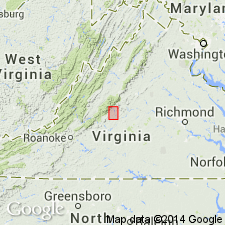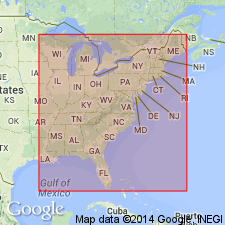
- Usage in publication:
-
- Shaeffer Hollow Granite*
- Modifications:
-
- Named
- Dominant lithology:
-
- Granite
- AAPG geologic province:
-
- Piedmont-Blue Ridge province
Summary:
The Shaeffer Hollow Granite is here named in the Roseland district of Nelson and Amherst Cos., VA. It consists of coarse-grained, leucocratic, blue quartz granite with tabular feldspar phenocrysts and porphyritic texture. Is cut by dikes of, and forms xenoliths in, the Roses Mill pluton. Age is Middle Proterozoic based on U-Pb ages of 1787 and 980 Ma.
Source: GNU records (USGS DDS-6; Reston GNULEX).

- Usage in publication:
-
- Schaeffer Hollow granite
- Modifications:
-
- Overview
- AAPG geologic province:
-
- Piedmont-Blue Ridge province
Summary:
Unit is used informally on VA State map [and misspelled]. Described as leucocratic, coarse-grained, porphyritic, alkali feldspar-blue quartz granite. May contain as much as 10 percent biotite (after hornblende or pyroxene?). Accessories include ilmenite, apatite, and zircon. Gradational into mylonitic flaser gneiss. Contains granulite xenoliths. Age is Middle Proterozoic.
Source: GNU records (USGS DDS-6; Reston GNULEX).

- Usage in publication:
-
- Shaeffer Hollow Granite*
- Modifications:
-
- Geochronologic dating
- AAPG geologic province:
-
- Piedmont-Blue Ridge province
Summary:
Shaeffer Hollow Granite has 207Pb/207Pb age of 933 Ma (Herz and Force, 1987) and a U-Pb zircon upper intercept of 994 Ma (calculated by T.W. Stern from existing data).
Source: GNU records (USGS DDS-6; Reston GNULEX).
For more information, please contact Nancy Stamm, Geologic Names Committee Secretary.
Asterisk (*) indicates published by U.S. Geological Survey authors.
"No current usage" (†) implies that a name has been abandoned or has fallen into disuse. Former usage and, if known, replacement name given in parentheses ( ).
Slash (/) indicates name conflicts with nomenclatural guidelines (CSN, 1933; ACSN, 1961, 1970; NACSN, 1983, 2005, 2021). May be explained within brackets ([ ]).

